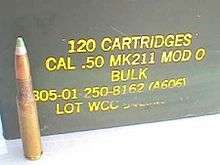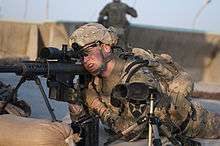Raufoss Mk 211
.svg.png)
The Raufoss Mk 211 is a .50 caliber (12.7×99mm NATO) multipurpose anti-matériel projectile produced by Nammo (Nordic Ammunition Group, a Norwegian/Finnish military industry manufacturer of ammunition), under the model name NM140 MP.[1] It is commonly referred to as simply multipurpose or Raufoss, which refers to Nammo's original parent company: Raufoss Ammunisjonsfabrikker (Ammunition Factory) in Raufoss, Norway, established in 1896. The "Mk 211" name comes from the nomenclature "Mk 211 Mod 0" used by the U.S. military for this round.[2][3]
The multipurpose name is based on the projectile having an armor-piercing (tungsten core), an explosive, and an incendiary component, thus making it capable of penetrating lightly armored targets and causing damage to personnel inside the target after penetration. It is a suitable round for engaging helicopters, aircraft and lightly armored vehicles, as well as unarmored vehicles, and it is capable of igniting jet fuel. The Mk 211 has about the same destructive power as a standard 20mm round against such targets.[4]
The Mk 211 is a very popular .50 caliber sniper round used in the Barrett M82 rifle and other .50 BMG rifles.[4] It is also often used in heavy machine guns such as the M2 Browning. Due to its popularity several U.S. arms manufacturers produce the round under license from NAMMO Raufoss AS.[5] There is also a tracer variant, the MK300, used in the Browning heavy machine gun.
Design details
The multipurpose concept developed by Raufoss is unique in that, instead of using a mechanical fuse, it uses a pyrotechnical detonation train to ensure proper detonation of the explosive and incendiary components.[4]
Identification


This round is usually identified by a green over white paint tip mark.[3] Its tracer variant, which is typically only used with belt-fed machine guns in naval applications, includes a row of red paint between the green and white rows.
The headstamp on the casing will not help to identify the round as Raufoss. Common headstamps are used, and only designate the location, and year of final assembly of the completed round. Headstamps in general will read as (but are not limited to): HXP 89, WCC 94, LC 01, TW 4 or FN 91. The two of three letter prefix (HXP, WCC, LC, TW, or FN) designates the place of assembly; the two-digit suffix numbers specify the production year (Twin Cities (TW) uses only a single digit; i.e. 4 would be 1974, 1984, 1994, 2004 and so on).
Legality
There has been much debate over whether the Mk 211 projectile is legal to use against personnel, or if it is strictly anti-matériel ammunition. The International Committee of the Red Cross has sought to have the ammunition banned, due to concern over the incendiary and explosive components and their effect on personnel. Under the St. Petersburg Declaration of 1868 the "military or naval" use of explosive or incendiary projectiles with a mass of under 400 grams is forbidden.[6] Very few nations were parties to the St. Petersburg Declaration, however, and that declaration does not govern the conduct of non-signatory parties. Further, the Hague treaties of 1899 and 1907 – which superseded the St. Petersburg Declaration, and were signed by a far wider circle of nations – do permit the use of such ammunition for auto-cannons and heavy machine guns. Machine guns firing .50 cal/12.7mm ammunition are heavy machine guns. At best, the ICRC's position can be applied to only a small group of nations that were parties to the St. Petersburg Declaration; at worst, the ICRC's position is made moot by more than 100 years of subsequent international treaties.
Trials conducted by Forsvarets Forskningsinstitutt (Norwegian Defence Research Establishment) have concluded that the ammunition most likely does not have an unlawful effect if unintentionally used against personnel, as the round will have penetrated the body and exited on the other side before the explosive and incendiary components of the round are initiated.[7] Upon hitting a person the round will detonate about 50% of the time; if the target is wearing body armor a higher detonation frequency is to be expected (as shown by the ICRC tests carried out in 1999).[8] If detonated, the round will have a significant fragmentation and incendiary effect in a 30-degree cone behind the struck target, and this might affect others standing in the vicinity. The distance the round will travel from ignition to detonation is 30–40 cm, so if the target is hit at very specific angles the round may still be inside the target at the time of detonation.
The official stance of the Norwegian Government is that the 12.7 mm MP round should not be used against personnel, but an exception has been made for snipers using the round — due to the practical limitations of snipers having to change the type of ammunition used when switching between hardened and soft targets. It is being exported strictly in an anti-matériel capacity.
Most nations using the round train their soldiers not to deploy the projectile against personnel, but in the heat of battle such regulations are easily overlooked. Also, many parties currently fielding the ammunition have no such regulations, including the U.S., whose policy is that the ammunition is suitable for use against all targets.
See also
References
- ↑ "Nammo AS - 12,7mm (.50 Cal)". Nammo AS. Archived from the original on April 15, 2008. Retrieved 2010-08-27.
- ↑ "20mm AMR – New Use for Unused Ammo" (PDF). Defense Technical Information Center. p. 12. Retrieved 2010-08-27.
- 1 2 "Army Ammunition Data Sheets for Small Caliber Ammunition" (PDF). Defense Technical Information Center. April 1994. p. 150. Retrieved 2010-08-27.
- 1 2 3 John Pike (May 13, 2010). "Mark 211 .50-caliber Multipurpose Ammunition". Globalsecurity.org. Retrieved 2010-08-22.
- ↑ "Small Caliber Ammunition" (PDF). ATK. pp. 31–32. Retrieved 2010-08-27.
- ↑ "St Petersburg Declaration 1868". International Humanitarian Law. International Committee of the Red Cross. Retrieved 2010-08-27.
- ↑ "The Effect of 12.7mm Multi-Purpose (MP) Ammunition in Human Tissue" (PDF). Forsvarets Forskningsinstitutt. October 16, 2003. Retrieved 2010-08-22.
- ↑ Moosberg, Louise (August 18, 2003). "Does the Swedish use of the 12.7mm Multipurpose Projectile undermine the St. Petersburg Declaration?" (PDF). Uppsala University. Archived from the original (PDF) on May 19, 2006. Retrieved 2010-08-22.
External links
- International Efforts to Restrict or Prohibit Military Small Arms: Annual Report 2001 - Office of the The Judge Advocate General of the Army
- Mark 211 .50-caliber Multipurpose Ammunition - Global Security
- Official Mk211 site at NAMMO.com